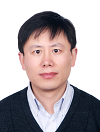A Special Issue for the IEEE Symposium on Haptic Audio Visual Environments and Games 2011 (HAVE 2011) will be published in the IEEE Transactions on Instrumentation and Measurement (TIM). Accepted Symposium papers that are registered and presented at HAVE 2011 (included poster papers) are eligible to submit, by November 29 2011, an extended version to the special issue. These manuscripts must be technically extended beyond the scope of the paper that appears in HAVE 2011. Please follow very carefully the guidelines given below. In addition, more information on special issues in general can also be found on TIM's website here.
Guest Editors:
 Peter X. Liu, Carleton University, Canada
Peter X. Liu, Carleton University, Canada
 Atif Alamri, King Saud University, Saudi Arabia
Atif Alamri, King Saud University, Saudi Arabia
 Guangjun Liu, Ryerson University, Canada
Guangjun Liu, Ryerson University, Canada
Manuscript Guidelines for the Special Issue
Your accepted HAVE 2011 paper is automatically invited to this Special Issue, with the condition that the paper be registered and presented (or posted) at HAVE 2011. Failure to meet the conditions will prevent the paper from appearing in the special issue. The guidelines for the special issue papers are as follows:
- The paper must be technically extended beyond the scope of the paper that appears in HAVE 2011.
- The paper must be submitted in PDF and online to TIM http://tim.allentrack.net no later than November 29, 2011. Please note that, because this date is controlled by TIM itself and not by the guest editors, it is the absolute final deadline and no extensions will be given. Late papers will not be able to be uploaded and hence will not be considered. Please do not submit papers by email to the guest editors: they will not be accepted.
- At the time of submission, the authors must also provide detailed information in a separate PDF file explaining how the special issue paper is a technically-extended version of the proceedings paper.
- The HAVE 2011 paper MUST be clearly referred to in the text and listed as one of the references in the special-issue paper.
- When uploading your manuscript click on “Special Issue Manuscript” in the “Manuscript Upload Instructions” page of the Allentrack System. Then, in page #1 of “Submit Manuscript” you must choose "HAVE2011". Subsequently, in the same page and in the “Files to Upload” section you MUST upload two files; one containing a detailed explanation of how the paper is TECHNICALLY extended beyond the scope of the proceedings paper and another which is a PDF copy of the HAVE 2011 paper. To this end, you must put the number “2” in the small box in front of “Extension Beyond Proceedings & Copy of Proceedings (if any was published)” so that the system allows you to upload these two files. Consequently, these two files will be available to the reviewers. Failure to submit a detailed explanation of the TECHNICAL extension and a PDF copy of the Proceedings paper will result in the immediate return of the manuscript to the author(s) as an unacceptable submission. Please note that for the extended version, you are essentially writing a journal paper or IEEE Transaction on Instrumentation and Measurement (TIM). Please follow TIM’s format on their website in terms of paper size, margins, fonts, maximum number of pages, etc. It is also very important that the presentation of the paper, in terms of title, abstract, and introduction, makes it clearly related to instrumentation and measurement. For Haptics this should be straight forward as Haptics are instruments, but for papers focusing on audio/visual aspects only, it might be more challenging and require more work. It is also highly recommended that your paper include at least 3-4 references from past TIM papers.
Please note that the submitted papers will be reviewed to ensure that relevance and quality requirements for TIM are met. After this review, up to 10 of the accepted papers will be published in the special issue, and the rest of the accepted papers will be published directly in TIM as regular papers.
Important Dates
Submission site opens: November 15, 2011
Submission site closes : November 29, 2011 Note: because this date is controlled by TIM itself and not by the guest editors, it is the absolute final deadline and no extensions will be given. Late papers will not be able to be uploaded and hence will not be considered. Please do not submit papers by email to the guest editors: they will not be accepted.
First Decisions: January 15, 2012
Final decisions: March 15, 2012